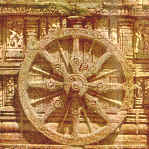|
|
India has been the birthplace of 3 major religions: Hinduism, Buddhism and Jainism. Many others have entered the country by land or by sea and have flourished in a climate of tolerance. Of these, Islam and Christianity have special space.
The majority of the people in India are Hindus. Their religion has roots thousands of years old in simple forms of animism, but it has also gathered into its fold many later cults. Objects to worship, customs and beliefs tend to vary in importance in different localities, but essentially, Hindu Philosophy teaches the oneness of Supreme Soul, of which individual souls are but manifestations. The four Vedas, the oldest surviving literature in the world are scared texts of Hindus. Two great and ancient epics, Ramayana and Mahabharata (comparable to Iliad and Odyssey of ancient Greeks) have inspired philosophy, ethics and art of Indian people.
Out of Hinduism developed 3 new religions: Buddhism, Jainism and centuries later Sikhism. Buddha laid emphasis on right conduct and non-violence and the religion that he founded spread far field and is today a major world faith. Mahavira, a contemporary of Buddha, founded the religion of Jains, preaching salvation through non-violence, righteous through and deeds and sanctity of all living things.
Sikh religion had its beginnings in the early 16th century as reformist movement in Punjab and was led by Guru Nanak, who preached the oneness of God and equality of all men. Guru Nanak and great teachers , who followed him repudiated superstition, empty ritual dogma and idolatry. Sikhs are enjoined not to cut their hair or shave. The customary headgear for men is a turban. Punjab is their home but, as an enterprising, hard-working people, they have settled in all parts of India and in many countries abroad.
The virile religion of Islam , which came from North and West in the wake of invading forces in 12 century AD, had profound influence on life in many parts of India. Persian and Saracenic ideas grafted on to the existing culture in India, produced remarkable achievements in architecture, painting and music.
India has the third largest Muslim population in the world and has produced great figures in Muslim philosophy and theology. Akbar, Mongol Emperor sponsored Persian translation of Ramayana and Mahabharata, the great epics of Hindus, and later many of Upanishads (philosophical speculations of the later Vedic period) were translated into Persian.
Christianity came to India earlier than almost anywhere else outside its own home in Middle East. St. Thomas the Apostle is believed to have come to the South of India in the first century and to have made many converts. Syrian Christian Church of Kerala traces its roots to these conversions. Morco Polo, who visited Kerala in 1293, refers to Nestorian Christians he met there. Later in 1544, St. Francis Xavier spent three months in Kerala and the chapel in Kottar is believed to have been built by him. In 1972, there were about 11 million Christians in India sharing fully in the national life of the country.
A community, known as White Jews came to South India to escape persecution. They came in the ships of King Solomon, and the present day coastal village of Puvar in Kerala is believed to be the port of Ophir, where they traded gold and silver to buy the spices of East. Small numbers of White Jews still live in Cochin.
Parsis, followers of Zoroaster, came to India from Persia during 8th century, seeking shelter from religious persecution and are small but important and prosperous community. They live mostly in Maharashtra and Gujarat, but are found in small numbers all over the country.

|
|

